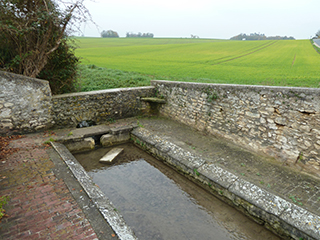Prochain point : lat="49.026686" lon="1.74662"

Grez Wash House
At the edge of the Fontenay Stream
Wash houses suitable...
The water for a wash house comes either from a spring or a river. The Fontenay Stream, which supplies this wash house with water, rises to the north of the village, above the Château du Mesnil. It flows down into the castle grounds, where it forms a huge reservoir that then irrigates the valley bearing its name. Its flow is strong enough to operate no less than three mills along its course: the grande vallée, the moulin de la mairie and the moulin des prés. A hundred or so metres away, two tributaries flow into it, the Marais Brook on the right bank and the Mian Stream on the left.
...for all circumstances
Wash houses built on riverbanks have walls on three sides. Along the waterside, the best-designed and most recent wash houses often had a moveable washboard that could be adjusted according to the level of the river. But the river could also be diverted to fill up a tank in the centre of the wash house, where the washing stones could be set at several different levels to take high water levels into account.
Some had a compluvium, a roof that sloped down towards the wash house tank, allowing rainwater to be collected; this tank was known as an impluvium.
Other wash houses are built over springs. The most rudimentary ones consist of an open-air tank, possibly surrounded by a wall. Generally, the tank is in the centre of a long rectangular building.





